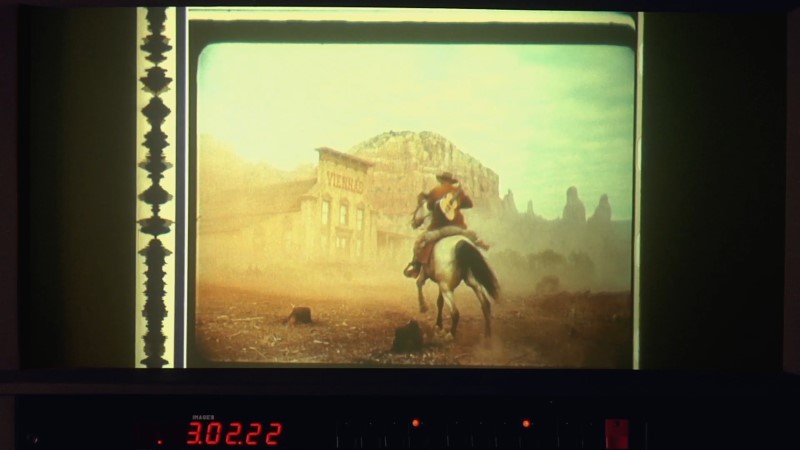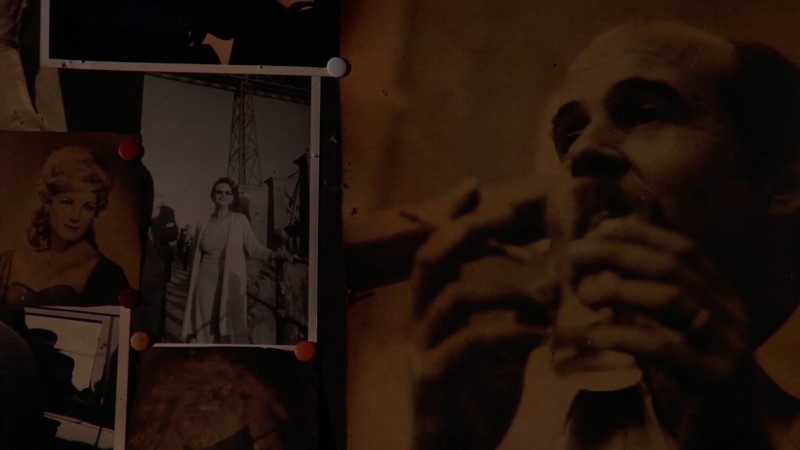Two or three things about an engaged film criticism today
Two or three things about an engaged film criticism today
By Victor Guimarães
When Dennis Vetter asked me to write an article in order to continue our discussions around autonomy, creation, and position at the panel with filmmakers Philip Scheffner and Merle Kröger and philosopher Juliane Rebentisch, I started thinking about some pathways that were suggested but not entirely followed during our conversation. After listening to B. Ruby Rich give her keynote speech to this year’s conference, I felt the urge to share two or three things I’ve been thinking about lately, in order to answer a question proposed at the description of our panel: “How can art and criticism challenge each other to pursue aesthetic freedom without losing sight of current events?”
In 1993, Noël Burch published the article “Cinéphilie et politique” in the communist French magazine La Pensée. The text starts as an infuriated response to the attacks on his latest books in France, but it develops into a diagnosis of the relationship between cinephilia and politics that was then hegemonic around the world. In face of the accusation – made in the pages of Cahiers du Cinéma – that his latest work was part of an “extremist and intolerant fever of simplistic sociologism,” Burch reacts by putting the very core of traditional cinephilia into question, stating that what was in fact consensus in 1993 – in film criticism, at universities and so on – was a sort of disengaged formalism: “Nowadays, this amazing consensus – Parisian at first, but whose sclerosing power, I see, affects all French-speaking and Latin countries – authorizes such a college professor to instruct the graduate candidate: ‘When you analyze a film, don’t look for meaning.’”

It’s stunning to go back to this article, published almost three decades ago, in light of recent developments in cinephilia and film criticism around the world. Not only does the hypothetical professor’s advice seem completely alien to the contemporary university environment, but anywhere you look today in film criticism, the most difficult thing to find is a single text that follows Susan Sontag’s attempt to build “an erotics of art,” in place of a hermeneutics. What we most see is precisely what Sontag was reacting against in 1964: films being reduced to their context, films being mistreated as a statement of the director, form being considered as a decorative accessory to that misleading entity called content. The most common reading experience for someone who is interested in film criticism today is to go through an entire text where the visual and sonic work of a film is blatantly ignored. We live in an environment where, very often, all that seems to matter is not matter, but, precisely, meaning.
In 1997, when Adrian Martin introduces the work of Nicole Brenez in Screening the Past, he asks: “Once we have demolished all those simplistic notions of analogy and resemblance, of film as mere mirror or reflection, where and how do we situate the mutual action of film-forms and historical forces?” In 2021, the question not only remains intriguing and relevant, but we also feel the urge to ask again: have we? Have we abandoned those simplistic notions? Everywhere in film criticism, what we most see is articles treating films as if they were mirrors of historical forces. Texts assuming a closed circuit between social positions and film characters; texts having a glaring difficulty when dealing with films that work outside the realm of mimesis and transparency. Or even worse: texts advocating for a cinema that mirrors an adjusted reality, a comfortable film world where power imbalances and contradictions have been cleaned up. A 2013 article by Nicole Brenez defines the problem with precision: “Films, whatever they are, including the coldest industrial ones, are often reduced to their scriptwriting schemes, their material determinations, their conditions of reception. What gets lost is one of the most dynamic issues in thinking about films: grasping the power of displacement, the critical potential of images.”
Noël Burch’s attempt to bring meaning – and thus politics – back to cinephilia in 1993 makes us think of the propositions for a “new cinephilia,” such as the one defended by Girish Shambu in his recent manifesto published in Film Quarterly: “The pleasures at the heart of the old cinephilia are predominantly aesthetic. The new cinephilia has a broader definition of pleasure: it values the aesthetic experience of cinema, but it demands more. It finds pleasure, additionally, in a deep curiosity about the world and a critical engagement with it.” When Shambu speaks of a “new” cinephilia, he seems to be working in the same trenches as Burch – rejecting the excessive formalism of old cinephilia. But how can operating with such a binary opposition help us navigate contemporary cinephilia and film criticism?
Shambu’s diagnosis of “old cinephilia” is extremely reductive. If we believe critical engagement with the world had no place in the history of Cahiers, where would we put Jacques Rivette’s “De l’abjection,” not to mention the “red” period of Jean-Louis Comolli, Jean Narboni, Sylvie Pierre, Serge Daney and so on? If we reduce the history of old cinephilia to French auteurism, what would we call the counter-hegemonic efforts of film critics and programmers such as Mabel Itzcovich, Paulo Emílio Salles Gomes, Claire Johnston, or Clyde Taylor – just to name a few – in the 1960s, ’70s, and ’80s? Critical engagement in cinephilia didn’t start yesterday, nor has it been absent from the most important critical endeavors of the 20th century.
I come from a critical tradition where this kind of dualistic separation doesn’t exist. For the “critical engagement with the world” has been a keystone in peripheral cinephilias at least since the early 1960s, coupled with the most beautiful immanent analyses and the most intransigent demands for formal experimentation. Speaking from a Latin American perspective, when Fernando Birri wrote “Cinema and underdevelopment” in 1962, when Glauber Rocha read “An aesthetics of hunger” in Pesaro in 1965, when Fernando Solanas and Octavio Getino distributed mimeographed copies of “Towards a Third Cinema” in Viña del Mar in 1969, or when Julio García Espinosa published “For an imperfect cinema” in Cine Cubano magazine in 1969, they were all performing, albeit with very different arguments and several differences in perspective, a double gesture: defying the normative patterns established by canonical film criticism and proposing a cinema where revolutionary engagement and formal experimentation could work together. Both aspects are addressed by Solanas and Getino at the same time: “Our time is one of hypothesis rather than of thesis, a time of works in process – unfinished, unordered, violent works made with the camera in one hand and a rock in the other. Such works cannot be assessed according to the traditional theoretical and critical canons. The ideas for our film theory and criticism will come to life through inhibition-removing practice and experimentation.” It is not a paradox that the most militant of all texts in the history of film theory begins with a Frantz Fanon epigraph that says: “We have to invent. We have to discover.”
So when B. Ruby Rich says, in her keynote speech for this year’s conference, “I don’t believe in taste, I think auteurism is a cheat, I think cinephilia is a cult,” my first temptation is to agree with her all the way. Especially living in an underdeveloped country, I am aware of the dangers of those religious terms. But at the same time, I believe those words can still be a battlefield worth occupying. How can we broaden our horizons and repertoires of taste, without giving up on sensibility? How can we overcome auteurism without sacrificing form and style? How can we reinvent cinephilia, that “dead star” of ancient times, as Noël Burch calls it, without underestimating the importance of aesthetic pleasure?
I do not believe in auteurism when it means creating a pantheon of untouchable cinematic gods. I do not believe in auteurism when it equates the work of a filmmaker to the gesture of a demiurge, ignoring the multiple aesthetic and historical forces at work inside a work of art. I do not believe in auteurism when it becomes a shield to avoid dealing with a fascinating environment of films created outside the mainstream or the festival circuit, films that are anonymous, films that are collective, films that very often cannot be confined to a single subjectivity. For instance, I strongly believe that a deep encounter with this anonymous video of a camera falling from the sky into a pigpen can reveal a lot about a genealogy of self-destruction in cinema, especially when compared to a vast range of experimental film works. On the other hand, I do believe in auteurism when it is used to recognize the outstanding style of Sara Gómez when framing an interview, her unique methods of documentary, or the subtle ways in which her films defied the rigid framework of propaganda filmmaking inside the Cuban Institute of Cinematographic Art and Industry in the 1960s.
I do not believe in taste when it’s reduced to rankings, lists, and notes – as beautifully elucidated by Elena Gorfinkel in her recent manifesto “Against lists.” But I do believe in taste when it means a powerful, singular encounter between a spectator and a work of art. An encounter in which both sides experience a displacement – the film becomes displaced by the work of the spectator, and the spectator is displaced by the work of the film. Taste is historically and socially built. It intersects with the dynamics of power and colonialism. But individual sensibility cannot be taken for granted.
I do not believe in taste when it’s reduced to a canon, but I do believe in taste when it means the powerful gesture of sharing a singular encounter with a film. “Others will love the things I loved,” says the beautiful verse by Sophia de Mello Breyner Andresen, used by Manuel Mozos to title his film in homage to the great Portuguese programmer João Bénard da Costa. If we take love, pleasure, enchantment out of film programming and film criticism, it becomes a field entirely dominated by management, “audience design,” or the next neoliberal term to come. Girish Shambu says in his manifesto: “In film culture, value flows from pleasure, and since the old cinephilia privileges aesthetic pleasure, it has long been the key criterion of value for films. For the new cinephilia, with its expansive notion of pleasure and value, films that center the lives, subjectivities, experiences, and worlds of marginalized people automatically become valuable.” But if we consider that films can be automatically valuable, aren’t we opening the door for commodification? When Netflix starts organizing its catalogue using categories such as “Films About Empowered Women” – whilst completely ignoring the works of Esfir Shub, Chantal Akerman, Sarah Maldoror, or even a Hollywood filmmaker like Dorothy Arzner – that new hegemonic channel for film experience is somehow echoing the words of the manifesto. Automation is the very language of the Netflix algorithm. But if cinephilia becomes a field where automatism is a valid method for selecting and valuing works of art, how can we distinguish Barbara Hammer’s persistent, beautiful, formally inexhaustible body of work from The L Word?

I do not believe in cinephilia when it’s reduced to a private, infantile, male-dominated game of disputing who has the bigger personal canon. But I do believe in cinephilia when it describes a vibrant, collective, diverse, densely sensitive space of sharing pleasure and building knowledge. Speaking from a local point of view, the main problem with the history of Brazilian cinephilia was never the lack of political engagement. As one of my colleagues said in our recent collective response to Shambu’s manifesto in Cinética, the major change we are experiencing nowadays is caused by “the reach and strength of the race and gender perspective, which have reoriented us in general.” That reorientation is crucial not only for the sake of social justice, but for the sake of art and criticism: when our environment becomes more diverse, when multiple perspectives are in dialogue, we can access new, beautiful, powerful encounters between films and spectators that would not have been possible in a homogeneous, white, male-dominated film world.
On the other hand, how can we position ourselves in terms of gender, race, sexuality, class, origin, without transforming that positioning into a shortcut to avoid complexity when dealing with works of art? For instance, if we simply avoid films that are creatively dealing with stereotyping – rejecting them as being the byproduct of oppression – what do we do with the fascinating depictions of hysteria in the work of Brazilian filmmaker Ana Carolina? Erika Balsom offers a beautiful pathway to confront that problem in her strong critique of Iris Brey’s book Le Regard féminin in Cinema Scope: “Why not give up on searching for the female gaze and persist instead in the call for another gaze, to borrow the name of the London-based feminist film journal? And yet another and another? It would leave open an intersectional space of invention and difference; it would remain sensitive to historical specificity; and it would welcome a plurality unconstrained by a binary opposition to maleness — something hardly possible in a rule-based approach that designates particular qualities as inherently feminine and others not.”
How can we recognize our relative privileges and our relative oppressions, without transforming every single critical gesture into a statement about our social position? The answer to that question cannot be an individualized one. We have to remain open to conflict and, at the same time, work actively to build alliances. We have to practice historical reparation every day, without avoiding the task of facing problematic films and creating critical conversations between different perspectives. This is a prime moment to bring back Nicole Brenez’s “principled empiricism,” as she wrote in her letter to Jonathan Rosenbaum, Adrian Martin, Kent Jones, and Alexander Horvath in 1997: “always placing your confidence in the film, always presuming that a film can think as well as a theoretical text.” We should be aware of social positioning when dealing with films, but we should never avoid the possibility of being displaced by a film. A film can not only confirm but also trouble our own self-understanding. Some of the best encounters I ever had with films were the ones in which I exited the experience being less certain about my place in the world.
In order to be politically effective and aesthetically open, we have to understand the field we are working in. No “activist film criticism,” as Dennis Vetter called it in his opening statement to this conference, can be done when we don’t consider the complex relations between aesthetics and politics. Several years ago, in a staff meeting with my fellow workers at Cinética, we collectively arrived at what seemed to be an important task for us at that moment: “to place ourselves at the standpoint of intervention.” But what does it mean to intervene in our environment? A politically engaged film criticism is impossible without an awareness of the specific politics of film forms. A formally engaged film criticism is impossible without an awareness of the aesthetic diversity of the world we live in. For a film is not an aesthetical or a political monad. Nor is the world.
A video of the panel “Creation and Position – Autonomy in Art and Criticism” and the entire conference day can be found here.
Texts Cited
Balsom, Erika. “In search of the female gaze.” Cinema Scope #83 (Summer 2020). https://cinema-scope.com/features/in-search-of-the-female-gaze/
Brenez, Nicole. « La Critique comme concept, exigence et práxis”. La Furia Umana, 17, 2013. http://www.lafuriaumana.it/index.php/29-archive/lfu-17/1-la-critique-comme-concept-exigence-et-praxis
Burch, Noël. “Cinéphilie et politique.” La Pensée. Republished in the collection De la beauté des latrines : pour réhabiliter le sens au cinéma et ailleurs, Paris, L’Harmattan, 2007, p. 63-76. Quotation from Portuguese translation by Leticia Weber Jarek published at http://vestidosemcostura.blogspot.com/2021/02/cinefilia-e-politica.html.
“Conversas ao redor de uma nova cinefilia. Parte 1 – Binarismos e cisões.” Cinética. http://revistacinetica.com.br/nova/conversa-ao-redor-de-uma-nova-cinefilia-parte-1-binarismos-e-cisoes/
Gorfinkel, Elena. “Against lists.” Another Gaze, November 2019. https://www.anothergaze.com/elena-gorfinkel-manifesto-against-lists/
Martin, Adrian. “Ultimatum: an introduction to the work of Nicole Brenez.” Screening the Past. December 22, 1997. http://www.screeningthepast.com/issue-2-classics-re-runs/the-ultimate-journey-remarks-on-contemporary-theory/
Shambu, Girish. “For a New Cinephilia.” Film Quarterly 72 (3), 2019, p. 32–34.
Solanas, Fernando & Getino, Octavio. Towards a Third Cinema. Republished in Movies and Methods: An Anthology. Edited by Bill Nichols. p. 44-64. Phoenix: University of Arizona Press, 1976 [1969].
